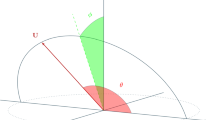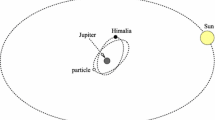Abstract
An approximate solution of the encounter problem of two small satellites describing initially elliptical orbits around a massive oblate primary is obtained. The equations of motion of the center of mass of the two masses are developed in the most general form without any restrictions on the orbital elements. The method of multiple scales which seeks a solution whose behavior depends on several time scales is used. To overcome the singularity the equations of motion are transformed to the Struble variables. An analytical second order theory of the evolution dynamics is obtained. A MATHEMATICA program is constructed. The evolution dynamics of the orbital parameters between the perturbed and the unperturbed cases are plotted. The effect of changing eccentricity and changing inclination on the orbital parameters are highlighted.







Similar content being viewed by others
References
Brumberg, V.A., Ivanova, T.V.: Encounter in the Keplerian field: analytical treatment. Celest. Mech. Dyn. Astron. 49(2), 133–144 (1990)
Brunini, A.: The effect of distant stellar encounters on planetary systems. II. Astron. Astrophys. 293, 935–940 (1995)
Guzzo, M., Lega, E.: On the identification of multiple close encounters in the planar circular restricted three-body problem. Mon. Not. R. Astron. Soc. 428, 2688–2694 (2013)
Henon, M., Petit, J.M.: Series expansions for encounter-type solutions of Hill’s problem. Celest. Mech. 38(1), 67–100 (1986)
Kevorkian, J.: The two variable expansion procedure for the approximate solution of certain non-linear differential equations. In: Rosser, J.B. (ed.) Space Mathematics. Lectures in Applied Mathematics, vol. 7, p. 206. Am. Math. Soc., Providence (1966)
Kevorkian, J., Cole, J.D.: In: Perturbation Methods in Applied Mathematics. Applied Mathematical Sciences, vol. 34. Springer, Berlin (1981). X, 558 S., 79
Lega, E., Guzzo, M., Froesché, C.: Detection of close encounters and resonances in three-body problems through Levi-Civita regularization. Mon. Not. R. Astron. Soc. 418, 107–113 (2011)
Liou, J.-C.: Collision activities in the future orbital debris environment. Adv. Space Res. 38, 2102–2106 (2006)
Moons, M., Delhase, F., Depaepe, E.: Elliptical Hill’s problem (large and small impact parameters). Celest. Mech. 43, 349 (1988)
Namouni, F., Luciani, J.F., Tabachnic, S., Pellat, R.: A mapping approach to Hill’s distant encounters: application to the stability of planetary embryos. Astron. Astrophys. 313, 979–992 (1996)
Petit, J.M., Henon, M.: Satellite encounters. Icarus 66(3), 536–555 (1986)
Spirig, F., Waldvogel, J.: The three-body problem with two small masses: a singular-perturbation approach to the problem of Saturn’s coorbiting satellites. In: Szebehely, S., Szebehely, V.G. (eds.) Stability of the Solar System and Its Minor Natural and Artificial Bodies, vol. 154, pp. 53–63. Reidel, Dordrecht (1985). NAS Institute
Struble, R.A.: A geometrical derivation of the satellite equations. J. Math. Anal. Appl. 1(3–4), 300–307 (1960)
Valsecchi, G.B.: Close encounters and collisions of Near-Earth asteroids with the Earth. C. R. Phys. 6, 337–344 (2005)
Valsecchi, G.B., Milani, A., Gronchi, G.F., Chesley, S.R.: The distribution of energy perturbations at planetary close encounters. Celest. Mech. Dyn. Astron. 78(1–4), 83–91 (2000)
Waldvogel, J., Spirig, F.: Co-orbital satellites and Hill’s lunar problem. In: Roy, A.E. (ed.) Long-Term Dynamical Behavior of Natural and Artificial N-Body Systems, pp. 223–234. Reidel, Dordrecht (1988)
Acknowledgements
The author is deeply indebted and thankful to the deanship of the scientific research and his helpful and distinct team of employees at Taibah university, Medina, KSA. This research work was supported by a grant No. (3017/1434).
The author would also wish to record here his indebtedness and thankfulness to the Professors Mohammad Radwan and Fawzy Ahmed Abd El-Salam for their valuable help during the preparation and reviewing process through finalizing this work. Also the author wish to thank the reviewers for their valuable and fruitful comments as well as for their potential reading and suggestions.
Author information
Authors and Affiliations
Corresponding author
Rights and permissions
About this article
Cite this article
Abd El-Bar, S.E. Orbital evolution dynamics of two satellites in encounter phase using multiple scales expansion. Astrophys Space Sci 350, 155–168 (2014). https://doi.org/10.1007/s10509-013-1744-3
Received:
Accepted:
Published:
Issue Date:
DOI: https://doi.org/10.1007/s10509-013-1744-3




